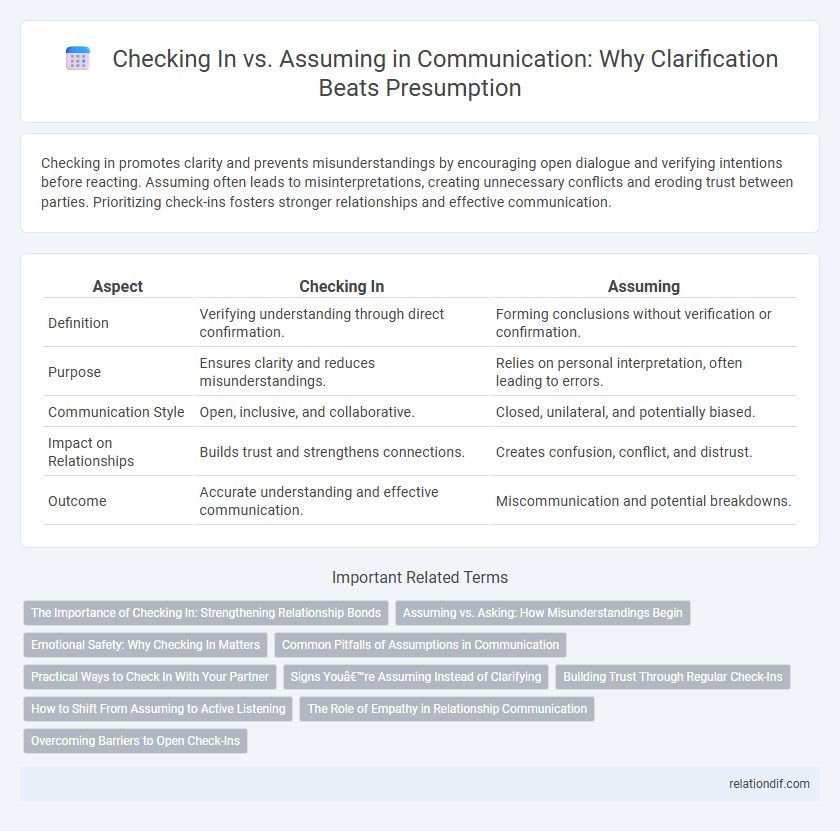Checking in promotes clarity and prevents misunderstandings by encouraging open dialogue and verifying intentions before reacting. Assuming often leads to misinterpretations, creating unnecessary conflicts and eroding trust between parties. Prioritizing check-ins fosters stronger relationships and effective communication.
Table of Comparison
| Aspect | Checking In | Assuming |
|---|---|---|
| Definition | Verifying understanding through direct confirmation. | Forming conclusions without verification or confirmation. |
| Purpose | Ensures clarity and reduces misunderstandings. | Relies on personal interpretation, often leading to errors. |
| Communication Style | Open, inclusive, and collaborative. | Closed, unilateral, and potentially biased. |
| Impact on Relationships | Builds trust and strengthens connections. | Creates confusion, conflict, and distrust. |
| Outcome | Accurate understanding and effective communication. | Miscommunication and potential breakdowns. |
The Importance of Checking In: Strengthening Relationship Bonds
Checking in regularly fosters clear communication by validating emotions and preventing misunderstandings in relationships. It builds trust and emotional safety, enabling partners to express needs openly without fear of judgment. Prioritizing check-ins transforms assumptions into informed insights, strengthening relational bonds with genuine connection.
Assuming vs. Asking: How Misunderstandings Begin
Assuming intent or understanding without confirming facts often leads to communication breakdowns and conflicts in personal and professional relationships. Asking clarifying questions fosters transparency, reduces ambiguity, and ensures that all parties share the same understanding. This proactive approach to communication minimizes misunderstandings and promotes effective collaboration.
Emotional Safety: Why Checking In Matters
Checking in fosters emotional safety by ensuring open dialogue and mutual understanding, reducing the risk of misinterpretation and conflict. Emotional safety strengthens relationships and encourages vulnerability, making every participant feel valued and heard. Assuming, on the other hand, often breeds misunderstandings and emotional distance, ultimately undermining trust and connection.
Common Pitfalls of Assumptions in Communication
Assuming in communication often leads to misunderstandings because it bypasses the necessary step of verifying information directly with the other party. Common pitfalls include misinterpreting tone, intentions, or facts, which can escalate conflicts and erode trust. Checking in fosters clarity by encouraging active listening and asking clarifying questions, reducing errors caused by unchecked assumptions.
Practical Ways to Check In With Your Partner
Regularly asking open-ended questions fosters clarity and strengthens emotional connection in relationships. Utilizing reflective listening ensures both partners feel heard and understood, reducing misunderstandings. Scheduling brief, consistent check-ins helps maintain ongoing communication without feeling overwhelming.
Signs You’re Assuming Instead of Clarifying
Body language inconsistencies, such as avoiding eye contact or crossed arms, often signal that you're assuming rather than clarifying in communication. Verbal cues like vague responses or repeated questions indicate a lack of clear understanding. Recognizing these signs helps prevent miscommunication and promotes effective dialogue.
Building Trust Through Regular Check-Ins
Regular check-ins foster clear communication by validating assumptions and reducing misunderstandings, which strengthens trust within teams. By proactively engaging in consistent updates, individuals demonstrate accountability and openness, essential elements for collaborative success. Trust built through frequent, transparent communication enhances problem-solving and improves overall team cohesion.
How to Shift From Assuming to Active Listening
Shifting from assuming to active listening requires consciously pausing to engage fully with the speaker's words and emotions, avoiding pre-judgments. Techniques such as asking clarifying questions and summarizing what has been heard reinforce understanding and foster empathy. Emphasizing active listening reduces misunderstandings and builds trust within interpersonal communication.
The Role of Empathy in Relationship Communication
Checking in during conversations demonstrates empathy by acknowledging the feelings and perspectives of others, which fosters trust and deeper connection. Assuming intentions without verification often leads to misunderstandings and emotional distance, damaging relationship communication. Empathy-driven check-ins create a safe space for open dialogue, enhancing mutual understanding and respect.
Overcoming Barriers to Open Check-Ins
Overcoming barriers to open check-ins involves recognizing the pitfalls of assuming others' thoughts or feelings, which often leads to miscommunication and mistrust. Encouraging transparent dialogue and asking clarifying questions foster a culture where team members feel safe to express concerns or uncertainties. This proactive approach enhances mutual understanding and prevents conflicts caused by unverified assumptions.
Checking In vs Assuming Infographic

 relationdif.com
relationdif.com